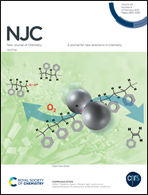A direct Z-scheme mechanism for selective hydrogenation of aromatic nitro compounds over a hybrid photocatalyst composed of ZnIn2S4 and WO3 nanorods†
Abstract
Nowadays, visible-light-driven photocatalysts are considered to be prospective candidates for solving the crisis of energy shortage and environment pollution. Herein, with the support of WO3 nanorods (NRs), which possess a fast electron transmission and low carrier diffusion, a series of direct Z-scheme ZnIn2S4/WO3 photocatalysts are exquisitely fabricated by an in situ self-assembly route with ZnIn2S4 (ZIS) and WO3 NRs. Photocatalytic activities towards both selective hydrogenation of aromatic nitro compounds and non-selective oxidation of organic compounds demonstrate that these as-fabricated heterostructured nanocomposites exhibit remarkably enhanced photocatalytic activities owing to the highly efficient separation of photogenerated electrons and holes. Furthermore, the characteristics of electron spin resonance (ESR) spectra clearly suggest that the as-fabricated nanocomposites follow the direct Z-scheme-dominated photoredox catalytic mechanism. Additionally, combining the results of ESR and X-ray photoelectron spectroscopy (XPS), it can be concluded that the photo corrosion of ZnIn2S4 is significantly postponed after integration with WO3 NRs. Finally, we will be greatly pleased if this work could afford a theoretical exemplification and synthetic strategy for rationally designing and utilizing direct Z-scheme photocatalysts.



 Please wait while we load your content...
Please wait while we load your content...